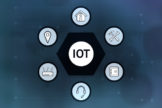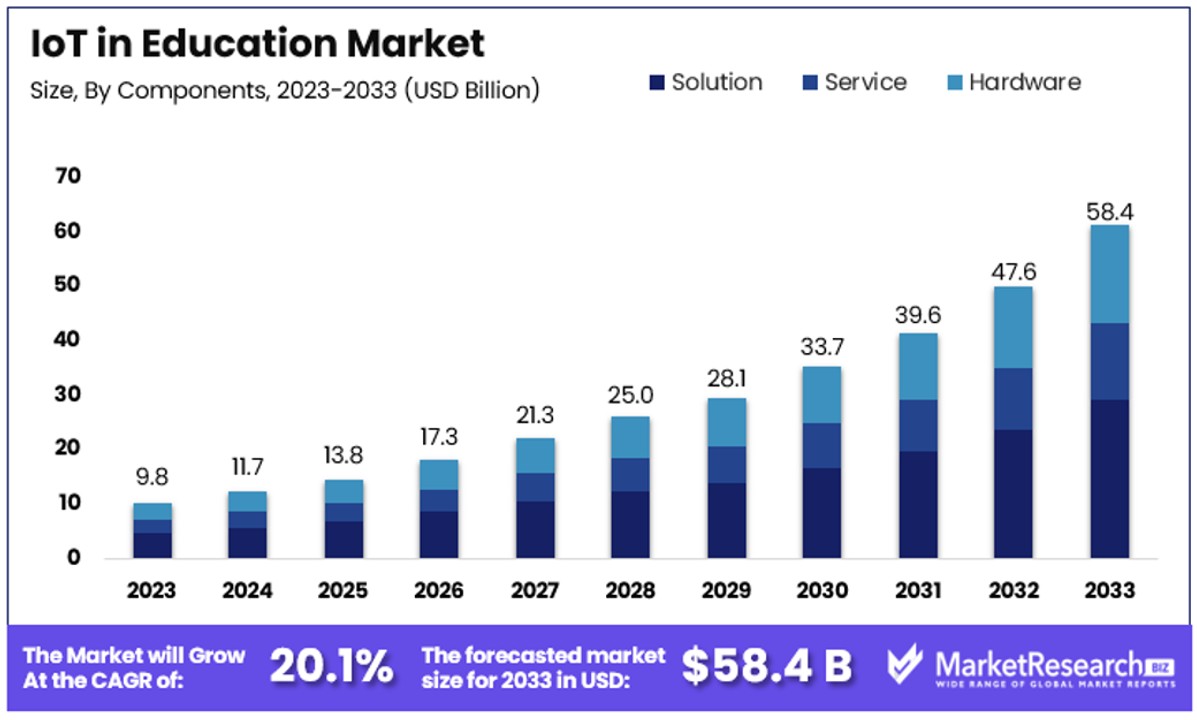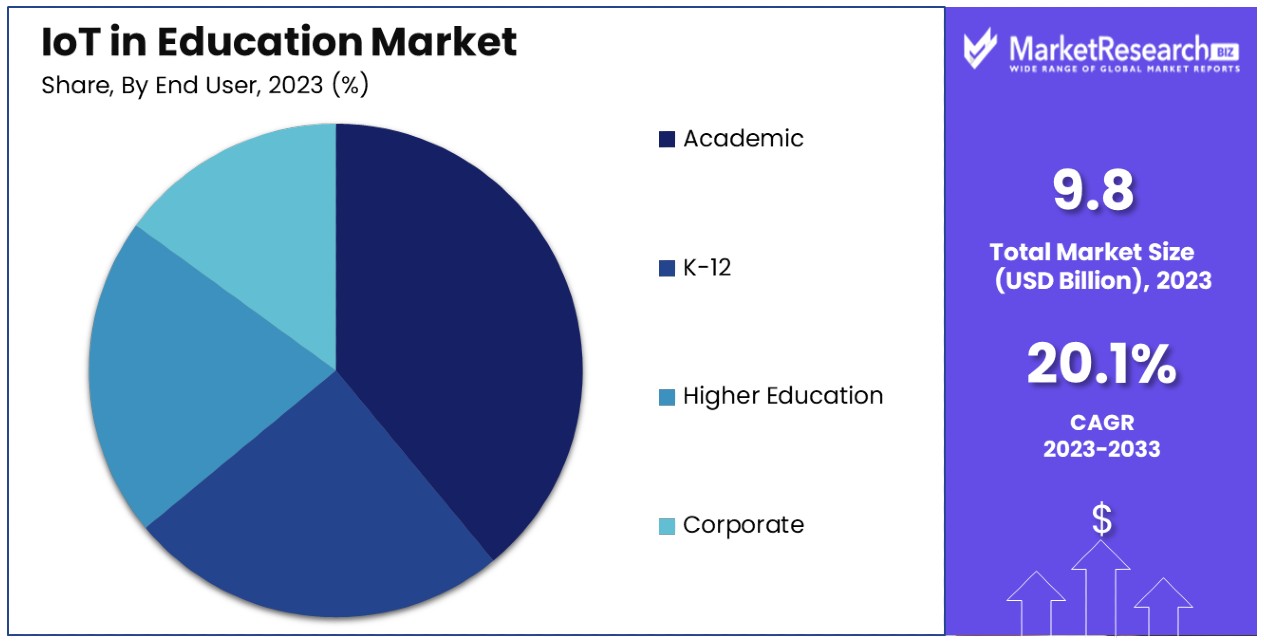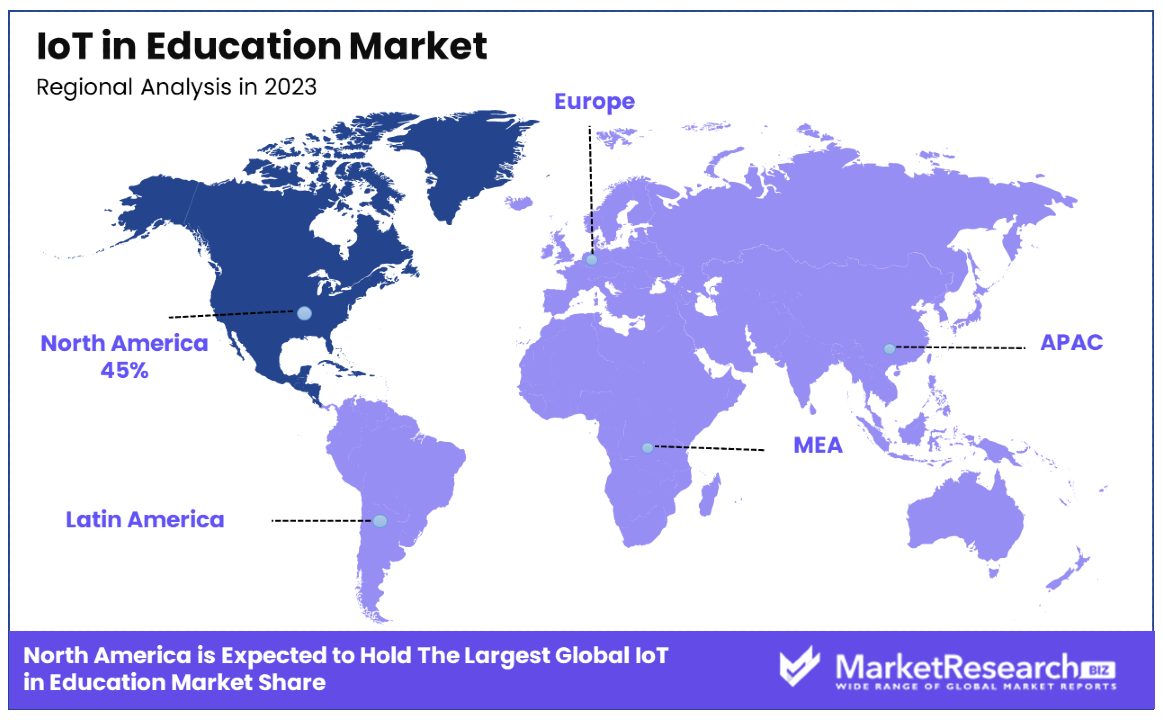
IoT in Education Market Report By Components (Solution, Service, Hardware), By Application (Classroom Management, Learning Management System, Surveillance, Administration Management, Big Data), By End User (Academic, K-12, Higher Education, Corporate), By Region and Companies - Industry Segment Outlook, Market Assessment, Competition Scenario, Trends and Forecast 2024-2033
-
10219
-
May 2024
-
290
-
-
This report was compiled by Vishwa Gaul Vishwa is an experienced market research and consulting professional with over 8 years of expertise in the ICT industry, contributing to over 700 reports across telecommunications, software, hardware, and digital solutions. Correspondence Team Lead- ICT Linkedin | Detailed Market research Methodology Our methodology involves a mix of primary research, including interviews with leading mental health experts, and secondary research from reputable medical journals and databases. View Detailed Methodology Page
-
Quick Navigation
Report Overview
The Global IoT in Education Market size is expected to be worth around USD 58.4 Billion by 2033, from USD 9.8 Billion in 2023, growing at a CAGR of 20.1% during the forecast period from 2024 to 2033.
The rise in advanced technologies and the adoption of e-learning methods are some of the main factors for the IoT in education market expansion. The Internet of Things (IoT) has a strong impact on education institutes. The usage of IoT technology has made life easier for students, teachers as well and parents as it is transforming into much smarter and more connected in many ways.
The Internet of Things in education is providing advanced smart classrooms, digital boards, and voice-based command technologies. It has advanced a lot and it can be used to keep the parents updated regarding the whereabouts of their kids, smart security cameras in the school, tracking the attendance automatically and many more can be used by the IoT.

Internet usage and e-learning have become one of the common teaching methods in many institutions. The application of IoT in education is several, and the execution for this disruption is wonderful.
As per an article published, it is estimated that 83.2% of all the kids who are coming in between 12 to 17 years old have a smartphone. Moreover, 73% of the parents stated that their kids have a smartphone between 11 to 13 years old, whereas 31.0% of parents said that their children have one between the ages of 6 to 10 years.
Additionally, new Richmond schools in Tipp City, Ohio are consuming approximately USD 128,000 each year by utilizing an internet-based technique that regulates all the mechanical equipment inside the building.
The IoT has provided education with digital infrastructure, which offers a new learning experience. The old way of teaching is gradually being eliminated due to advanced technology in learning. Such a type of IoT device that enhances the learner’s efficiency is the C-Pen tool. It is a device that looks like a pen and has sensors for text recognition. Users can effortlessly swipe the device over the book and visualize text on the screen.
Advancement in technology has offered more advantages for teachers, as they can teach students from any corner of the world due to its remote learning facility. The rise in demand for IoT in the educational sector with its advantages of new technologies will help in market expansion of the IoT in the education market during the forecast period.
Key Market Segments
- Market Value: The Global IoT in Education Market is projected to reach USD 58.4 billion by 2033, showing substantial growth from USD 9.8 billion in 2023, with an impressive CAGR of 20.1% during the forecast period from 2024 to 2033.
- Components Analysis: Solutions, including software platforms and applications, are the primary drivers of market growth, enabling integration and management of IoT devices in education.
- Application Analysis: Classroom management applications lead as the dominant segment, enhancing teaching effectiveness and student engagement.
- End User Analysis: The academic sector, covering K-12 and higher education, is the largest end-user of IoT in education, driven by the demand for technologically enhanced educational infrastructures and personalized learning.
- Regional Insights: North America Dominates the market with a 45% market share, reflecting advanced technological infrastructure and a strong emphasis on education technology.
- Key Players: Leading players in the IoT in Education Market include IBM Corp., Cisco Inc., Intel, Google LLC, Amazon Web Services, Inc., Oracle Corporation, Microsoft Corporation, Huawei Technologies Co., Ltd., Samsung Electronics Co. Ltd., SAP SE, Schneider Electric, Hitachi Vantara LLC, and Robert Bosch GmbH.
- Analyst Viewpoint: Analysts anticipate continued growth in the IoT in Education Market, driven by increasing adoption of e-learning platforms, smart classroom solutions, and personalized learning technologies.
- Growth Opportunities: Growth opportunities lie in the development of innovative IoT solutions tailored for education, expansion into emerging markets, and strategic partnerships between technology providers and educational institutions.
Driving Factors
Classroom Modernization Spurs IoT Adoption in Education
The modernization of classrooms and curricula is significantly influencing the growth of the IoT in the education market. Educational institutions are increasingly integrating IoT solutions to enhance learning environments, making them more interactive and data-driven.
This modernization includes smartboards, IoT-enabled attendance systems, and personalized learning devices. As curricula evolve to include more digital literacy and tech-focused content, the demand for IoT solutions in education continues to rise. This trend suggests a future where digital and physical learning environments are seamlessly integrated, driven by IoT technologies.
Development of New IoT-Based Education Solutions Expands Market
The development of new IoT-based education solutions is catalyzing the expansion of this market. Innovators and educators are collaborating to create IoT solutions specifically designed for educational purposes, such as enhanced classroom management tools, improved student engagement mechanisms, and sophisticated data analysis capabilities for personalized education.
This ongoing innovation is not only meeting current market demands but also paving the way for future growth, as new applications for IoT in education are continually explored and realized.
Growing Investment in EdTech Fosters IoT Market Growth
The increasing investment in education technology is a major factor contributing to the growth of the IoT in the education market. As both public and private sectors recognize the value of integrating technology into education, investments are flowing into the development and deployment of IoT solutions.
These investments are enabling schools and educational institutions to adopt advanced technologies, driving market growth. The long-term implications of this trend include a more interconnected, data-driven, and efficient educational landscape, where IoT is a key component in delivering quality education.
Restraining Factors
Increasing Incidences of Cyber-Attacks on Educational Institutions Restrain IoT in Education Market Growth
The growing frequency of cyber-attacks targeting educational institutions poses a significant barrier to the growth of IoT in the education market. These attacks not only compromise sensitive data but also raise substantial concerns over data security and privacy. Educational institutions, handling vast amounts of personal and academic information, become prime targets for cybercriminals.
The fear of data breaches and the potential legal and reputational repercussions deter many schools and universities from adopting IoT technologies. This reluctance is exacerbated by the often limited cybersecurity resources available in educational settings, implementing IoT solutions appears riskier.
Complexity and Implementation Challenges Restrain IoT in Education Market Growth
The complexity of IoT systems and the challenges associated with their implementation also restrict the market's expansion. IoT in education involves integrating various technologies – sensors, networking equipment, data analytics tools – into existing educational infrastructures. This integration can be daunting, particularly for institutions without substantial IT expertise.
The need for significant upfront investment in both hardware and training further complicates matters. Additionally, there's the challenge of ensuring that IoT solutions are compatible with existing educational tools and pedagogies. These complexities can be overwhelming, particularly for smaller institutions, hindering the widespread adoption of IoT technologies in the education sector.
Components Analysis
Software Solutions Drive Growth in IoT Education Market, Revolutionizing Classroom Management and Learning Experiences
Solutions in the IoT education market, including software platforms and applications, are the primary drivers of market growth. These solutions enable the integration and management of various IoT devices in educational settings. They facilitate a range of functions from interactive learning and student engagement tracking to resource management.
The growth in this segment is propelled by the increasing adoption of e-learning platforms, smart classroom solutions, and the integration of AI and analytics in education. Advanced solutions that offer personalized learning experiences and efficient campus management are particularly influential in this segment’s growth.
Services, including installation, maintenance, and training, are essential for the effective deployment and utilization of IoT solutions in education. The hardware segment, encompassing sensors, interactive whiteboards, and wearables, plays a critical role in enabling interactive and immersive learning environments. While these segments are smaller than solutions, they are integral to the functionality and expansion of IoT in education.
Application Analysis
Classroom Management Applications Lead IoT Adoption in Education, Transforming Teaching Methods and Student Engagement
Classroom management applications of IoT stand out as the dominant segment, enhancing teaching effectiveness and student engagement. These applications include attendance tracking, real-time feedback mechanisms, and interactive learning tools. The integration of IoT in classroom management transforms traditional teaching methods, offering more dynamic and responsive learning environments.
Learning Management Systems (LMS) are crucial for e-learning, providing platforms for content delivery and assessment. Surveillance applications, including security cameras and emergency response systems, ensure safety on campus. Administration management applications streamline institutional operations. Big Data analytics in IoT aids in educational decision-making and personalized learning strategies. Each of these applications contributes uniquely to the market's growth.
End User Analysis
Academic Sector Emerges as Primary End User of IoT in Education, Fostering Technological Innovation and Personalized Learning
The academic sector, encompassing K-12 and higher education, is the most significant end-user of IoT in education. This segment's growth is driven by the increasing demand for technologically enhanced educational infrastructures, the need for efficient learning solutions, and the focus on personalized education. IoT applications in academics range from smart classrooms and labs to campus management systems, significantly enhancing the quality and accessibility of education.
The corporate sector utilizes IoT in education for training and development purposes. Corporate training programs increasingly adopt IoT solutions for employee skill development, certification courses, and professional growth. While a smaller segment compared to academics, it is growing steadily, driven by the need for continuous learning and skill upgrading in the corporate world.

Key Market Segments
By Components
- Solution
- Service
- Hardware
By Application
- Classroom Management
- Learning Management System
- Surveillance
- Administration Management
- Big Data
By End User
- Academic
- K-12
- Higher Education
- Corporate
Growth Opportunities
Data-Driven Decision Making
IoT's ability to gather and analyze large volumes of data is transforming how educational decisions are made. Sensors and connected devices within classrooms can collect data on student attendance, engagement levels, and resource utilization. This data is then analyzed to uncover trends and patterns in student behavior and learning outcomes.
Educational institutions can use these insights to optimize curriculums, adjust teaching methods, and better allocate resources, ensuring that educational offerings are tailored to meet the needs of all students. Moreover, predictive analytics can help identify students who might require additional support, enabling early intervention to improve educational outcomes. By leveraging data-driven insights, schools can enhance educational quality and operational efficiency, making informed decisions that benefit both students and educators.
Internet of Things (IoT) for Environmental Monitoring in Schools
IoT technology is increasingly being used to monitor and manage the environmental conditions within educational facilities, contributing to healthier and more sustainable learning environments. IoT sensors deployed throughout school buildings can measure a variety of environmental parameters such as air quality, humidity, temperature, and light levels. This data is crucial for ensuring that the conditions in classrooms are conducive to learning.
Poor air quality, for instance, can significantly affect students' cognitive abilities and overall health. By monitoring these conditions in real-time, schools can adjust HVAC systems dynamically to improve air quality and ensure optimal learning conditions. Additionally, IoT devices can help in energy management by controlling lighting and heating based on real-time occupancy data, thereby reducing energy consumption and operational costs. This application of IoT not only promotes a healthier learning environment but also instills a sense of environmental responsibility among students by incorporating sustainability into the school's operations.
Trending Factors
Enhanced Learning Experiences through Smart Classrooms
IoT technology is revolutionizing traditional educational setups by introducing smart classrooms. These classrooms are equipped with IoT-enabled devices such as smart boards that allow interactive learning, IoT projectors that facilitate multimedia presentations, and sensors that adjust lighting and temperature based on occupancy and environmental conditions.
This integration enhances the teaching experience by enabling features like remote learning, where students can interact with lessons from any location. Additionally, smart devices can track student engagement and comprehension in real-time, providing immediate feedback to educators. This not only makes learning more dynamic and engaging for students but also assists teachers in tailoring lessons to meet the varied learning speeds and styles of students, ultimately fostering a more inclusive and effective educational environment.
Improved Safety and Security
In the industry of education, IoT is playing a crucial role in enhancing safety and security measures. Schools are employing IoT technologies such as connected surveillance cameras and motion sensors to monitor activities in real time, ensuring a safe environment for students and staff. IoT-enabled wearables can serve as safety devices for students, equipped with features like panic buttons that can send instant alerts to school authorities and emergency services.
Furthermore, advanced IoT systems can monitor entry and exit points and even track the whereabouts of students within school premises, helping prevent unauthorized access and ensuring student safety. This technology not only helps in crisis management but also in routine surveillance, making educational institutions safer and more secure.
Regional Analysis
North America Dominates with a 45% Market Share
North America's substantial 45% share in the IoT education market is largely attributed to its advanced technological infrastructure and strong emphasis on educational innovation. The region's well-established network connectivity, widespread adoption of smart devices, and high investment in education technology (EdTech) are key drivers.
Additionally, the presence of major technology companies and startups focusing on IoT solutions in education contributes significantly to the market's growth. These entities are continually developing and deploying IoT applications in educational settings, enhancing learning experiences and operational efficiency.
There's a growing trend of digitizing classrooms and integrating smart technologies for personalized learning experiences. IoT applications in education, such as smart boards, student tracking systems, and connected classroom devices, are becoming increasingly popular.
The future of IoT in education in North America looks promising, with continued technological advancements and increasing digital literacy among educators and students. Additionally, post-pandemic, there’s likely to be an increased focus on hybrid learning models, where IoT will play a significant role in bridging physical and digital classrooms, sustaining North America's dominance in the market.

Europe Embraces Digital Transformation in Education
Europe's IoT in education market is expanding, driven by the region's strong focus on digital transformation in the education sector and substantial government funding. European educational institutions are increasingly adopting IoT solutions for smart campus initiatives and enhanced learning environments. The region’s commitment to data privacy and security, along with collaborative efforts across countries, further strengthens its market position.
Asia-Pacific Observes Rapid Growth and Technological Integration
The IoT in the education market in Asia-Pacific is experiencing rapid growth, fueled by the region's large student population and increasing investments in digital education. Countries like China, India, and Japan are aggressively integrating IoT technologies in educational settings, aiming to revolutionize traditional teaching methods. The growing internet penetration and mobile device usage in the region also contribute to the market's expansion, making Asia-Pacific a key player in the global IoT in the education landscape.
Key Regions and Countries
- North America
- The US
- Canada
- Mexico
- Western Europe
- Germany
- France
- The UK
- Spain
- Italy
- Portugal
- Ireland
- Austria
- Switzerland
- Benelux
- Nordic
- Rest of Western Europe
- Eastern Europe
- Russia
- Poland
- The Czech Republic
- Greece
- Rest of Eastern Europe
- APAC
- China
- Japan
- South Korea
- India
- Australia & New Zealand
- Indonesia
- Malaysia
- Philippines
- Singapore
- Thailand
- Vietnam
- Rest of APAC
- Latin America
- Brazil
- Colombia
- Chile
- Argentina
- Costa Rica
- Rest of Latin America
- Middle East & Africa
- Algeria
- Egypt
- Israel
- Kuwait
- Nigeria
- Saudi Arabia
- South Africa
- Turkey
- United Arab Emirates
- Rest of MEA
Key Player Analysis
In the burgeoning IoT in the education market, the listed companies collectively shape the sector with their diverse strategies and innovations. IBM Corp. and Cisco Inc., with their robust network infrastructures and data analytics capabilities, underscore the importance of secure and scalable IoT solutions in educational environments. Intel's contribution, through its advanced chipsets and processors, highlights the critical role of hardware in powering IoT applications.
Google LLC and Amazon Web Services, Inc., leading in cloud services, demonstrate the significance of cloud computing in managing and processing the vast amounts of data generated by IoT devices in education. Oracle Corporation and Microsoft Corporation, with their comprehensive enterprise solutions, showcase the potential of integrating IoT with existing educational technology infrastructures.
Huawei Technologies Co., Ltd., known for its telecommunications expertise, and Samsung Electronics Co. Ltd., with its array of connected devices, reflect the market's trend towards enhancing connectivity and interactive learning experiences. SAP SE, through its analytics and business intelligence solutions, emphasizes the role of data-driven insights in transforming educational processes and outcomes.
Collectively, these companies not only propel the IoT in the education market but also represent a range of strategies – from infrastructure development to cloud-based services and data analytics – crucial in navigating this rapidly evolving and technologically advanced sector.
Key Players
- IBM Corp.
- Cisco Inc.
- Intel
- Google LLC
- Amazon Web Services, Inc.
- Oracle Corporation
- Microsoft Corporation
- Huawei Technologies Co., Ltd.
- Samsung Electronics Co. Ltd.
- SAP SE
- Schneider Electric
- Hitachi Vantara LLC
- Robert Bosch GmbH
Recent Development
- In November 2023, Wits University in South Africa announced significant achievements in the realm of IoT in education. They secured funding as a network partner of the African Engineering and Technology Network (Afretec). The Afretec Member Inclusive Digital Transformation Research Grant, totaling $300,000 US, was aimed at supporting collaborative efforts in knowledge creation among network partners over three years.
- In October 2023, the UK Government announced a significant boost in funding for innovation in cyber-physical infrastructure. They awarded £200,000 to the X-Catapult Consortium, which aims to create a vibrant community of tech experts bridging the gap between industry, academia, and the public sector.
- In October 2023, IBM and the Ministry of Electronics and Information Technology India collaborated to advance and accelerate AI, IoT, semiconductor, and quantum innovation for academic, startup, and innovation ecosystems.
- In August 2023, IoT Squared, a joint venture between Saudi Telecom Company and the Public Investment Fund (PIF), signed an agreement to acquire 100% of the technology company Machinestalk. This acquisition is part of Saudi Arabia's digital transformation efforts and aims to make the kingdom a hub for IoT technology. The deal will enable IoT Squared to enhance its field services capabilities, technology, and IoT platforms, supporting its goal to become a "one-stop-shop" for IoT solutions.
Report Scope
Report Features Description Market Value (2023) USD 9.8 Billion Forecast Revenue (2033) USD 58.4 Billion CAGR (2024-2033) 20.10% Base Year for Estimation 2023 Historic Period 2018-2023 Forecast Period 2024-2033 Report Coverage Revenue Forecast, Market Dynamics, Competitive Landscape, Recent Developments Segments Covered By Components (Solution, Service, Hardware), By Application (Classroom Management, Learning Management System, Surveillance, Administration Management, Big Data), By End User (Academic, K-12, Higher Education, Corporate) Regional Analysis North America - The US, Canada, & Mexico; Western Europe - Germany, France, The UK, Spain, Italy, Portugal, Ireland, Austria, Switzerland, Benelux, Nordic, & Rest of Western Europe; Eastern Europe - Russia, Poland, The Czech Republic, Greece, & Rest of Eastern Europe; APAC - China, Japan, South Korea, India, Australia & New Zealand, Indonesia, Malaysia, Philippines, Singapore, Thailand, Vietnam, & Rest of APAC; Latin America - Brazil, Colombia, Chile, Argentina, Costa Rica, & Rest of Latin America; Middle East & Africa - Algeria, Egypt, Israel, Kuwait, Nigeria, Saudi Arabia, South Africa, Turkey, United Arab Emirates, & Rest of MEA Competitive Landscape IBM Corp., Cisco Inc., Intel, Google LLC, Amazon Web Services, Inc., Oracle Corporation, Microsoft Corporation, Huawei Technologies Co., Ltd., Samsung Electronics Co. Ltd., SAP SE, Schneider Electric, Hitachi Vantara LLC, Robert Bosch GmbH Customization Scope Customization for segments, region/country-level will be provided. Moreover, additional customization can be done based on the requirements. Purchase Options We have three licenses to opt for: Single User License, Multi-User License (Up to 5 Users), Corporate Use License (Unlimited User and Printable PDF) -
-
- IBM Corp.
- Cisco Inc.
- Intel
- Google LLC
- Amazon Web Services, Inc.
- Oracle Corporation
- Microsoft Corporation
- Huawei Technologies Co., Ltd.
- Samsung Electronics Co. Ltd.
- SAP SE
- Schneider Electric
- Hitachi Vantara LLC
- Robert Bosch GmbH




